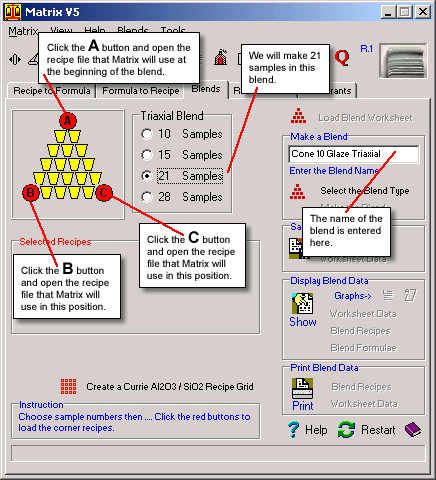|
Triaxial blends
are used when you may want to explore
- changes involving
two materials in a recipe e.g. if in the Cone 10 Glaze recipe
we wanted to explore the effects resulting from changes to both
EPK Kaolin and Silica.
- the variations
in colour from the addition of two colourants
- the results
of simply blending three different recipes
We will use
the first case above as an example. The blend we will design could
achieve the same result as the example used in Making
a Line Blend
Designing
the Corner Recipes for the Triaxial Blend
|
We will
need to have three recipes for the corners of the triaxial
blend..
Corner
A - will be the original Cone 10 Glaze recipe
Corner B - will be the Cone 10 Glaze recipe
with a reduction in the quantity of EPK Kaolin
Corner
C - will be the Cone 10 Glaze recipe with a reduction
in the quantity of Silica.
|
|
The following
recipes were prepared in the Recipe to Formula environment. After
making the reductions indicated above the recipes were converted
to total 100. Note that the recipe names include the letter which
indicates in which corner the recipe will be place.
All three recipes
were saved to the following location: C:/Prgram Files/Matrix/Blends/Cone
6 Triaxial/.
The Cone
6 Triaxial folder was created in the Blends folder to hold all of
the triaxial files.
|
Cone
10 Glaze A
|
|
| Australian
Potash Feldspar |
30
|
| Whiting |
21
|
| EPK
Kaolin |
19
|
| Silica |
30
|
|
|
Cone
10 Glaze B
|
|
| Australian
Potash Feldspar |
41.23
|
| Whiting |
28.86
|
| EPK
Kaolin |
9.03
|
| Silica |
20.88
|
|
|
Cone
10 Glaze C
|
|
| Australian
Potash Feldspar |
41.23
|
| Whiting |
28.86
|
| EPK
Kaolin |
9.03
|
| Silica |
20.88
|
|
Creating
the Triaxial Blend
Move to the
Blends environment and start the blend-making process by entering
the name Cone 10 Glaze Triaxial in the Blend
Name text box.
Follow the  to the
to the  Select the Blend Type and choose
the blend type and the number of samples for the triaxial as was
done in Making a Line Blend.
Select the Blend Type and choose
the blend type and the number of samples for the triaxial as was
done in Making a Line Blend.

Fig.1
Enter the blend name and select the blend type |
After
making the choices of blend type and sample number (Fig.1)
we click on the red corner glaze buttons to point Matrix to
the recipes to use in creating the blend.
Matrix
is now ready to make the blend so click the Make
Blend button.
Information
regarding the blend can now be viewed before saving the worksheet
and the recipes.
e.g. you
might want to check the range of samples on a graph incase
it needs to be increased or reduced.
Fi.g 2
shows the range of Al2O3 and SiO2 molecular parts represented
in each of the recipes in the blend.
|

Fig.2
The triaxial blend mapped on the Al:Si graph |
The A,
B and C recipes are located on the graph (Fig.2) and the samples
generated by Matrix for the triaxial are distributed betweeen
these corners.
The blend
worksheet and recipes may now be saved using the buttons in
the Save the Blend panel. More
...
You will
also want to print out the worksheet data so that you can
mix the blend mand you may want to obtain a printout of the
blend's recipes and formulae using buttons in the Print
Blend Data panel.
|
Physically
Making the Blend
To physically
making the blend you will need to print the worksheet data.
Click the
Worksheet Data button in the Print Blend Data
panel to get the printout you need. You can take this printout to
your glaze mixing lab and prepare the blend recipes and test tiles
for firing.
Assessing
the Blend After Firing
After you have
fired the blend you will want to refer to the individual recipes
representing the glazes on the test tiles.
Click the
Blend Recipes button in the Print Blend Data
panel to get the printout which includes all recipes and their unity
formulae.
Follow
these links for more information about:
|

